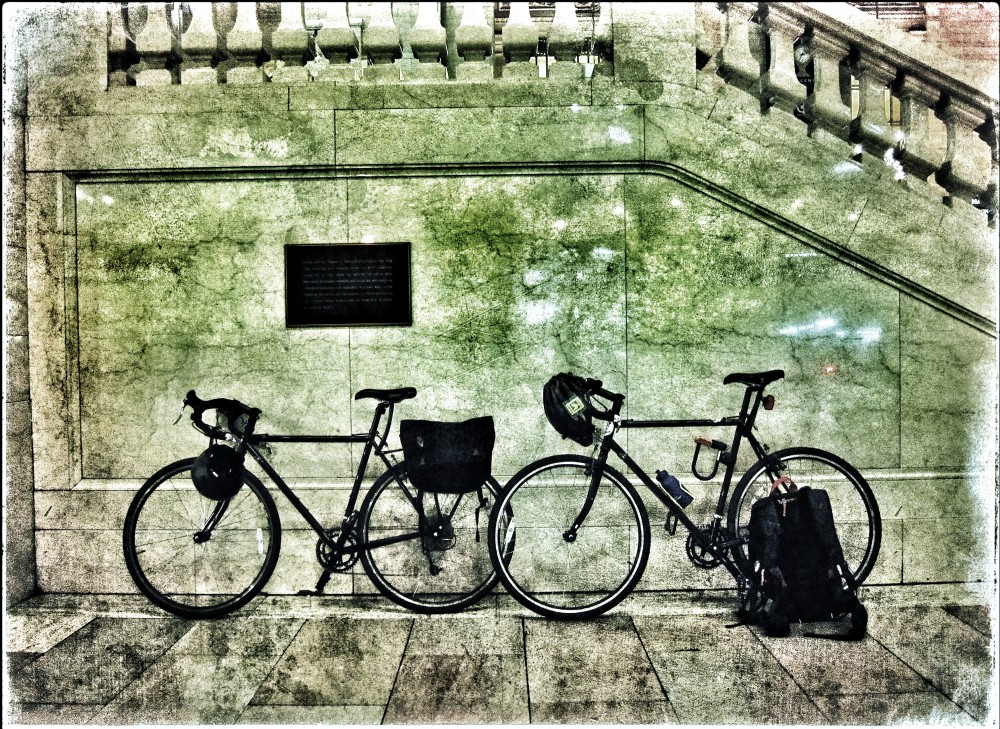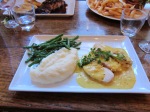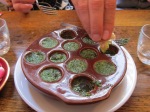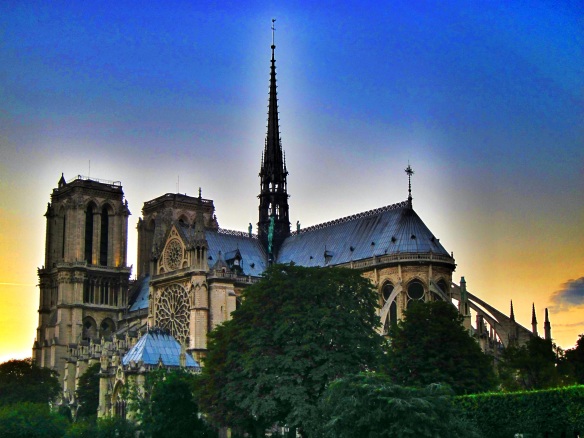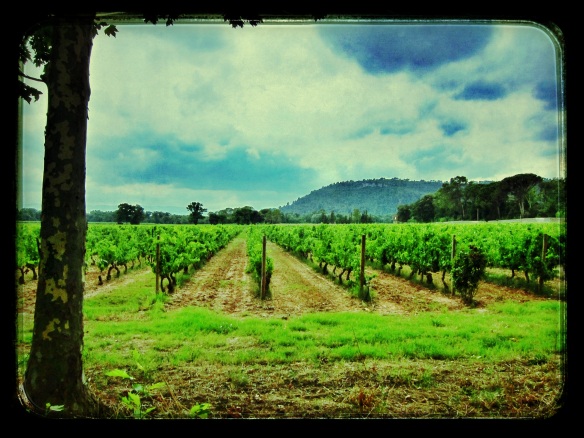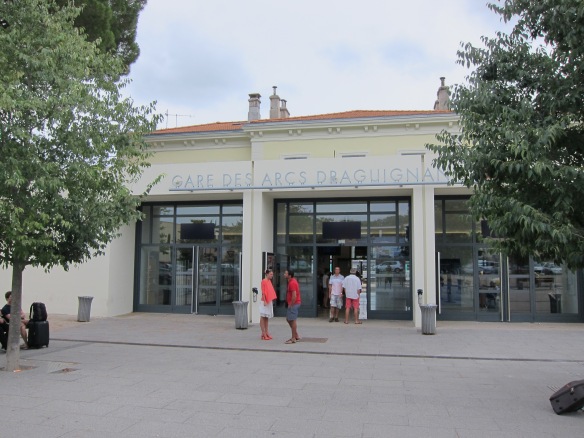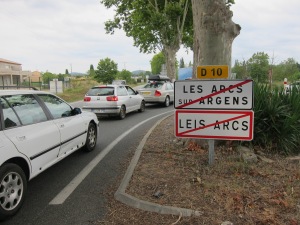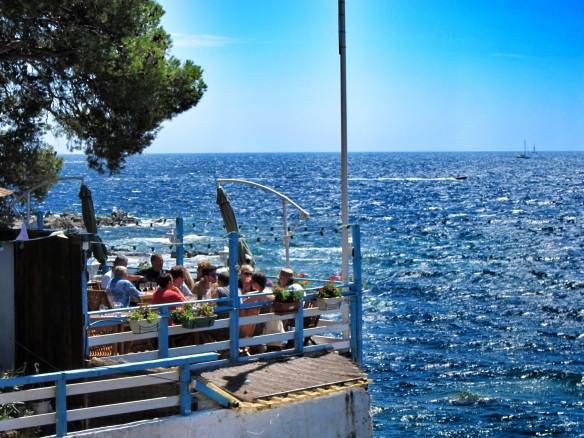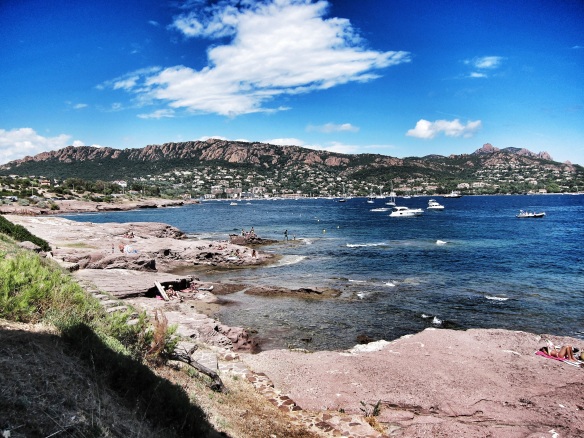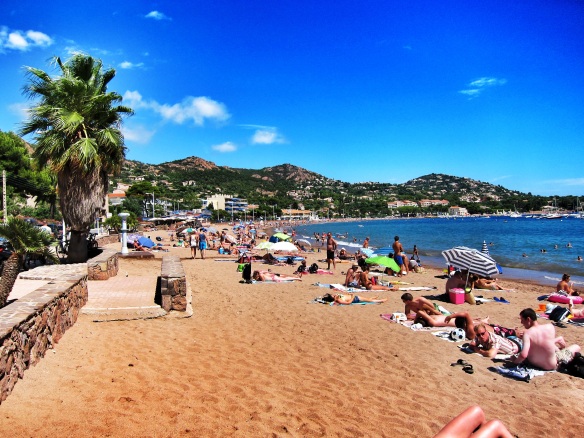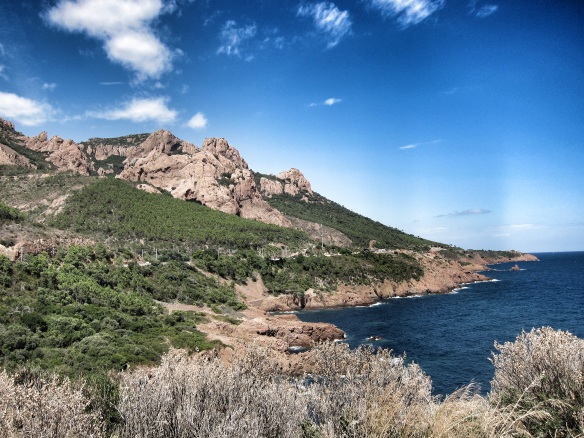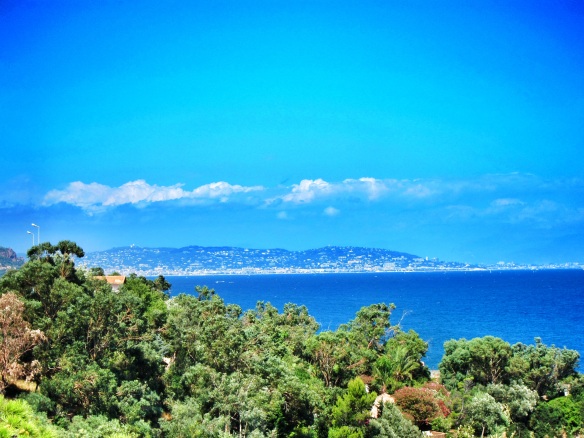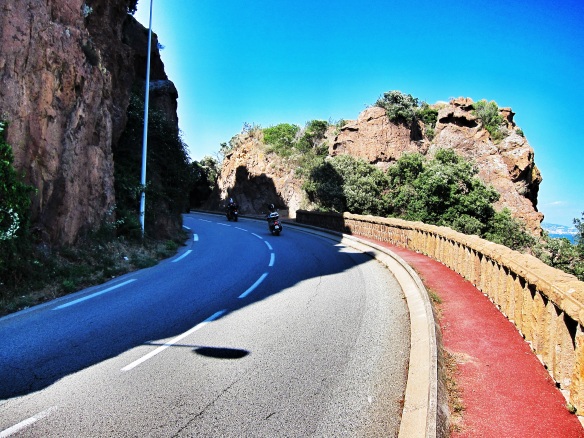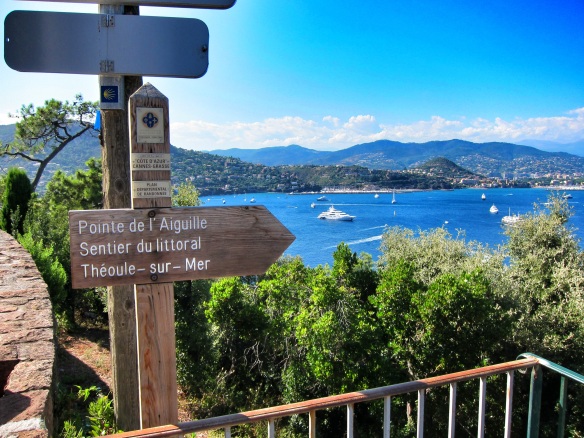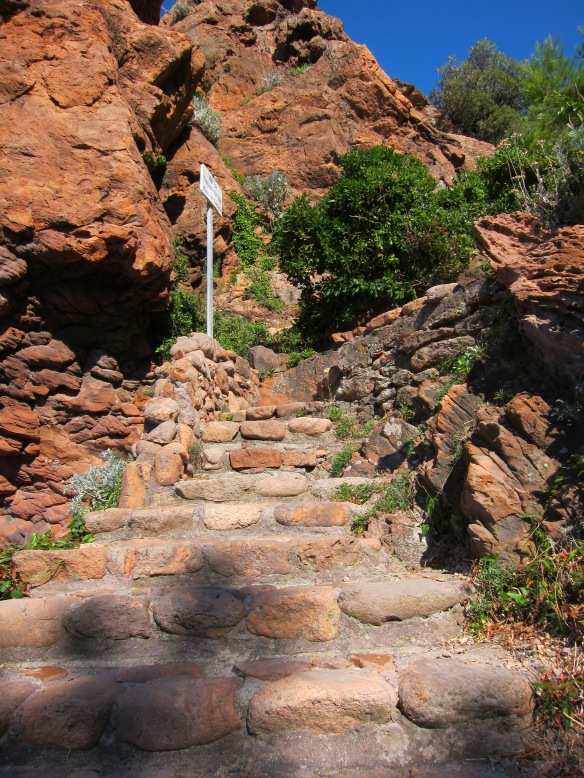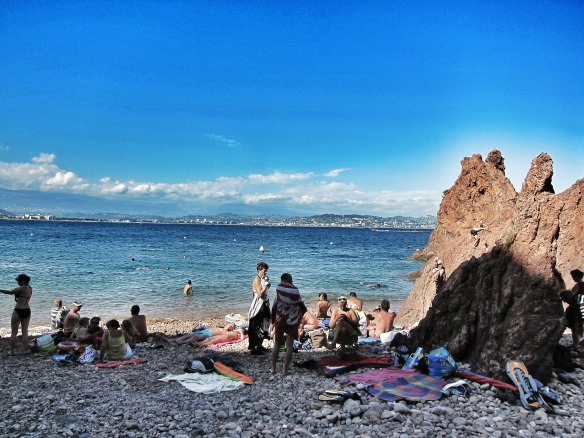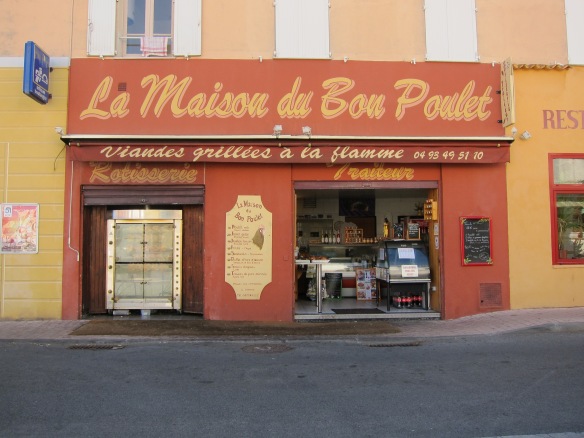Visit my new site Velotrope.org for more up-to-date content. Thanks!
I know what you’re thinking.
“Who in their right mind would want to escape Paris?”
That’s a good question. I certainly didn’t. If anything I want to go back and spend several weeks, if not several months or years.
During my recent trip to Europe, I only allocated one day from my schedule to visit the French capital. I don’t necessarily regret my decision since the places I opted to travel were equally exciting in their own right. But I have to admit, after spending just a few hours in Paris, I was seriously considering tweaking my plans to lengthen my stay in the City of Light.
Sometimes cities can be so rich in content that they’re daunting to visit. I was actually relieved that the Musée d’Orsay was closed on Monday since it narrowed down my choices to a more manageable selection. There can be so much to do and see that, even if I have a few days to get acquainted, I feel as if I’m just scratching the surface of a mountainside with my fingernail. The experience is akin to strolling through an aquarium versus scuba diving; being a detached observer of a beating pulse rather than being the blood pumping through it; watching those ephemeral moments of everyday life unfold and dissipate from the window of a moving bus or taxi.
Of course this is the burden of being a tourist. And tourists we generally are whenever we visit a city that is not our home. None of us have the time nor mobility to simply take up residence in whichever cities we find ourselves. We must play the role of the tourist and a significant role it is. As tourists we are the audience that shows up at the theater – eyes wide, mouths agape, hands poised for applause. We create the spectacle of the attraction with our gawking admiration, whereas the native will pass by daily some stunning achievement, attention diverted by whatever it is that’s playing on their iPod.
But if it’s the tourists who fill the seats, it’s the locals who are the stars of the show. We as visitors might say we’re in Paris to see the Eiffel Tower, the Louvre, or the Arc de Triomphe – but what we’re really there to see are the people who make the city vibrate. Can you imagine how empty and lonely a city would feel without its people – the merchants, the buskers, the cab drivers, the old woman waiting for the bus, the flamboyant guy on rollerblades rocking the daisy dukes? From my experience the best travel stories come not from exalted landmarks but from personal interactions and connections that we make with our temporary hosts.
My relationship with cities has evolved over the years. There are only a handful of cities with which I’d say I share an intimacy. New York is my soul mate. San Francisco is my beloved paramour. I’ve exchanged flirtatious glances with Berlin, Florence, Kyoto, and Lviv. Okay, I’ll stop with these metaphors before they become too graphic. But the point is, as I get older, I’m drawn less to the thumping energy of the busy urban centers and more towards the peaceful solitude of the deep countryside…
Wait… this is a bike blog, right? Okay. Let’s get to bikes.
In one minute. Back to Paris for a moment.
As I mentioned earlier I only spent about twenty-four hours in town, but I can attest that Paris is one of the most seductive and aesthetically beautiful cities I’ve ever had the pleasure of visiting.
I had booked a room at the Hotel Europe where a couple of friends were staying. Located in the heart of the Latin Quarter, the hotel was steps away from the Seine and many of the sights you’d want to see if you were only in Paris for one day. My room was snug and sported a sleek little balcony that overlooked the cafes on Rue Saint Séverin below.
My friends and I shared a tasty meal that night at Le Temps des Cerises, a picture-perfect bistro on Rue de la Cerisaie. Top photo is a dish of pork medallions, mashed potato, and haricots verts. Below, a hand eagerly mops up parsley butter from a plate of escargot.
Afterwards we ambled along the Seine with full stomachs, gazing at the exquisite French architecture sunbathing in the last vestiges of the late evening glow.
We walked along the river all the way to the Eiffel Tower. It was no quick endeavor and the walk took the better part of an hour. As we complained about our tender feet, people chugged past us on clumsy gray bicycles. The centerpiece of Vélib’, Paris’s large-scale public bicycle sharing system, these drab yet pragmatic clunkers were lined up in rows all throughout the city waiting to be ridden.
The following day I was to catch a train from Gare de L’est at five o’clock in the afternoon and I thought what better way to see Paris in my limited time than from the panoramic window offered by one of these city bicycles.
Vélib’ was launched in Paris in July of 2007. It’s success has paved the way for similar bicycle programs popping up in cities across the globe, such as the Boris Bikes you find in London (2010), or the ubiquitous shiny blue citibikes that are currently steamrolling New York (2013).
The way that Vélib‘ works is this: bicycles are available at stations set up throughout the city. You check out a bike, ride it for as long as you want, then return it to any station that has an empty space. If you just want a short-term ticket, as I did, you pay €1.70 for a one-day subscription. This subscription allows you to use the bicycles as much as you want in a 24-hour period. But you have to pay if you want to ride the bike for more than thirty minutes. The first half-hour is free, but the second half-hour costs €1. The third half-hour costs €2 and any half-hour after that costs €4. So, if you want to use a bike for say three uninterrupted hours, it would cost you €15 plus the €1.70 subscription fee. Not exactly cheap, but probably a bit cheaper than renting from a bike shop and much less hassle considering that picking up and returning the bike is a cinch. Also, if you’re willing to stop every thirty minutes and check in at a docking station you can ride all day for the cost of the €1.70 subscription (very cheap compared to the $9.95 you pay for a citibike in NYC). Essentially, these bike-sharing programs are well-tailored for Parisian commuters and tourists who are interested in stop-and-go sightseeing. If you prefer a long-distance ride that will take you outside the city, or if you don’t want to deal with the inconvenience of stopping every thirty minutes, then a local bike shop rental is probably your better option.
Now, the method of payment is where things become tricky. In order to check out a bicycle from one of the Vélib‘ stations, you must have an EMV credit card or “chip card”. That is, a credit card that contains an integrated circuit “chip” which allows you to transact with chip card-capable ATMs and POS terminals, such as the ones at the Vélib‘ docking stations. This is the credit card you use to pay as well as to put down a €150 deposit on the bike. While prevalent in Europe, the system of EMV standards is only slowly being implemented in the United States and many American credit and debit cards (mine included) lack this chip. This makes certain routine business transactions a headache – like buying gas or participating in a public bike-sharing program.
According to the Vélib‘ website, you can purchase subscriptions on-line up to two weeks in advance. Doing it this way, you receive a confirmation email with a user number and pin which you plug into the bike terminal when you’re ready to ride. Unfortunately, this requires the one thing I always forget to pack in my suitcase – forethought. As a result, my antiquated debit card and the soles of my shoes soon became acquainted with the Paris Métro.
See you another time La Ville-Lumière. We’re off to the countryside.
GOOD LORGUES
 The majority of my time in France was spent in the small commune of Lorgues (pronounced Lourjzhe – think Zsa Zsa Gabor). Surrounded by vineyards, olive groves, and white oak forests, Lorgues is situated halfway between Marseille and Nice in the Var department of the southeastern region of Provence-Alpes-Côte d’Azur. The town center itself is beautiful and ancient. The contemporary images of people wining and dining at alfresco cafes juxtaposes attractively with the narrow streets, medieval fortifications, and clusters of weather-beaten stone buildings with their faded pale-blue shutters. If it wasn’t for certain sartorial cues and the occasional cars dotting the landscape, you might second-guess the century.
The majority of my time in France was spent in the small commune of Lorgues (pronounced Lourjzhe – think Zsa Zsa Gabor). Surrounded by vineyards, olive groves, and white oak forests, Lorgues is situated halfway between Marseille and Nice in the Var department of the southeastern region of Provence-Alpes-Côte d’Azur. The town center itself is beautiful and ancient. The contemporary images of people wining and dining at alfresco cafes juxtaposes attractively with the narrow streets, medieval fortifications, and clusters of weather-beaten stone buildings with their faded pale-blue shutters. If it wasn’t for certain sartorial cues and the occasional cars dotting the landscape, you might second-guess the century.
My friends and I had rented a villa just outside the center of town for the week. I was trying to convince several of them to join me for a ride I had read about in a “Cycling France” Lonely Planet book I had picked up prior to the trip. The ride was called the “Mediterranean Promenade” and was described in the book as being an easy 32-km ride along a “curling coastal road [that] passes through idyllic Mediterranean summer villages and inlets.” The response I got from my friends was lukewarm.
Part of the reason for this lack of enthusiasm was the relentless summer heat. I suppose the idea of riding three or four hours in the baking sun is not appealing to everyone. The other issue was logistics. The ride was to begin in the coastal town of Saint-Raphaël and terminate in the coastal town of La Napoule. The route was bookended by train stations, so the idea was to drive (we had rented a car) to Saint-Raphaël and hire bikes from a shop called Atout Cycles. Then we’d ride along the curling coast up to La Napoule, take the train back to Saint-Raphaël, return the bikes to the shop, and drive back to Lorgues as new people, the idyllic Mediterranean etched in our hearts.. We would just have to make sure that we arrived back in Saint-Raphaël before the bike shop’s closing hours of seven pm. This sounded simple enough, but while researching local train service I noticed something problematic. I read on SNCF’s official site that TER trains (Train Express Régional) in Provence-Alpes-Côte d’Azur do not accept bicycles on weekdays between the hours of seven and nine am and four-thirty and six-thirty pm.
Unfortunately the ride, if it was going to happen at all, was going to happen on a weekday. And since there was no guarantee that we’d make it to La Napoule before four-thirty pm, we needed a train during “rush hour” in order to get back to Saint-Raphaël in time to return the bikes. But the final nail in the coffin was when we phoned Atout Cycles and learned that all their stock was booked for the week. Again, forethought – sitting next to my car keys on the coffee table back home.
Well, similar to the relief I felt about the Musée d’Orsay being closed on Mondays, so was the sense I got from my friends about the Mediterranean Promenade getting expunged from the list of things to do. But not me. I was bummed. My trip wasn’t meant to be a cycling vacation and I hadn’t planned or packed for any epic overnight cycling excursions, but I was hoping to at least squeeze in a good ride in France as I was able to do in England.
As luck would have it, my salvation was stashed among the cobwebs in the garage of our villa: two 26”, 21-speed, Decathlon Vitamin mountain bikes that looked as if they hadn’t been ridden in years. I dusted one off, gave some air to the tires and took it out for a spin around town. The bike was smaller than what I was used to riding. Also, plastic fenders held loosely on the front and rear wheels by shaky nuts and bolts rattled while in motion, giving the distinct sensation that the bicycle was going to break into pieces at any given moment. But the Vitamin held its own. The gears worked, it was easy enough up hills, and all things considered it was a smooth little ride.
Now the question was how I was going to get to Saint-Raphaël and the beginning of the coastal route without a car. We hadn’t paid to include my name on the insurance and registration documents, and besides, I have little experience driving a manual transmission. The car was not an option.
So I decided to ride from Lorgues to the coast. It would add about 40 km to the journey, but I figured the additional leg would provide some interesting scenery and I had confidence in the Vitamin. Still, I needed to figure out a way to get home. I scoured a map of the local area and saw that the nearest train station was Les Arcs-Draguignan, about 15 km or so from the villa. We had driven through Les Arcs earlier in the week on the way to the beach and the town was separated from Lorgues by a minor mountain. Luckily, it was the only big hill between our villa and the coast, descending steeply from Lorgues towards Les Arcs and the other towns that lead out to the beaches of Fréjus and Saint-Raphaël.
My plan was to ride from Lorgues to Saint-Raphaël where I’d jump on the coastal road up to La Napoule. Having reached La Napoule as my final destination, I’d board the train to Les Arcs-Draguignan, the last stop on the line. From Les Arcs I’d ride the 15km back home to Lorgues. I estimated the total trip would be about 90 km.
- Lorgues to Saint-Raphaël = 40km
- Saint-Raphaël to La Napoule = 35km
- La Napoule to Les Arcs = Train
- Les Arcs to Lorgues = 15km
- Total: 90km
The Ride: Lorgues to Mandelieu-la-Napoule (via Saint-Raphaël)
August 9, 2013
If you’d like to skip the prose and just want a bare bones list of directions, go here. The route is very simple and intuitive and you shouldn’t even need a map.
Our villa was located on a small road named Chemin du Peylong. If you exited the house and followed the road to the left, you could conceivably ride it for miles through country forest. It was just one of hundreds of local roads in the area, scattered across the countryside, an intricate network of veins, connecting tiny pockets of farmland with main roads. You could spend months getting to know all of these backroads and, in doing so I imagine, gain a fairly intimate knowledge of the area. Unfortunately, I had only one day and about 90km in front of me. So I opted for the main roads.
As in England, France’s major roads are divided into two kinds: A-roads and D-roads. England’s A-roads allow bicycles while the high-speed M-roads do not. In France, it’s the A-roads that cyclists must avoid, such as the A8 that tears across Provence from Marseille to Nice. French D-roads, on the other hand, are very bike-friendly and often have a wide rust-colored shoulder specifically for cyclists.
I cobbled together a day-pack of bottled water, energy bars, fruit, sausage, spare inner tubes, a mini-pump, a lock, some padded bike shorts just in case, a towel, and sunscreen. I made sure to bring everything I needed because many shops in this part of France like to take a midday siesta from noon until three pm. I applied a generous coat of sunscreen on my face and arms, grabbed my helmet, and was out the door by ten in the morning.
Running parallel to Chemin du Peylong on a south/southeast trajectory is the D10, or Route Des Arcs. This is the road that escorts you out of Lorgues towards the sea and the rest of Var. The D10 is a pleasant, flat and wide-open road flanked by grape fields on either side and forest extending beyond the farmland. You’re on this road for only several kilometers before you come to your first fork. Here you have a decision: continue on the D10 Route Des Arcs or bear right on the D48 towards Vidauban. For the purpose of this ride you want to continue on the D10 and follow signs towards Les Arcs. You will have the opportunity to visit the town of Vidauban on the way back if time and sunlight permit.
Shortly after you pass the Les Arcs/Vidauban fork, the bike shoulder disappears and the D10 winds steeply down into the tiny commune of Taradeau. At this point you’ve probably only been riding for about twenty minutes and this is more or less the first village you will encounter since leaving Lorgues. Once you cross a  small bridge, the road leads you into the quaint center of town. There is a church, a “tabac”, a small grocery store and a few other shops on this road if you’re in need of essentials (or divine intervention). Otherwise, simply continue on the D10 following signs towards Les Arcs.
small bridge, the road leads you into the quaint center of town. There is a church, a “tabac”, a small grocery store and a few other shops on this road if you’re in need of essentials (or divine intervention). Otherwise, simply continue on the D10 following signs towards Les Arcs.
The ride from Taradeau to Les Arcs is a flat, vast six-kilometer stretch of road that sees the return of the bike lane. When you come to the major roundabout, you’ll see signs pointing towards the town center and the Gare S.N.C.F. This is the Les Arcs-Draguignan train station that you’ll be arriving at later. However, unless you have a need for going into town, you should just continue on the D10 – this time following signs for Le Muy.
Almost immediately after passing through the roundabout, the D10 merges with the DN7 which will be your road all the way to the coast. Called Route d’Aix en Provence, the DN7 changes its name to Route de Fréjus after passing through Le Muy. It’s also at this point that the traffic starts to become slightly hectic as you approach the massive Hyper-U. France’s answer to Costco and Walmart, the Hyper-U is a mega-sized supermarket that looms almost anachronistically over the nearby vineyards. Even if you wanted to stop here for a quick shop or a look around, I wouldn’t recommend it. Although clearly visible from the DN7, the hypermarket is located several hundred meters off the road and the only access is via a high-speed exit ramp that obviously was not designed for bicycle traffic. Patrons of the Hyper-U are meant to fill the trunks of their cars with crates of food and other retail items. The business model is definitely not based on the stray cyclist wandering in for a toothbrush and a bottle of water.
If you’re looking for a quick break, I’d recommend instead stopping at this fruit stand just outside of Les Arcs. It comes up on your left-hand side shortly after joining the DN7. They sell fresh fruit, direct produce, cold beverages, and local varieties of wine if you’re so inclined.
Once beyond the perimeter of the Hyper-U, the DN7 calms down again and it’s a relaxing ride to Le Muy. By the time you’ve reached Le Muy, you’ve probably been on the road for about one hour and you have 16km ahead to Fréjus and the coast.
 However, these next 16km are not the prettiest. You could describe it as a shit taco. Every ride contains a shit taco and this is it. It’s not that the terrain is bad or that there are ass-kicking hills along the way. It’s just that the DN7 becomes busy and congested with beach traffic and you often find yourself relegated to the very margins of the road where there is not always a shoulder and the condition of the asphalt is frequently neglected.
However, these next 16km are not the prettiest. You could describe it as a shit taco. Every ride contains a shit taco and this is it. It’s not that the terrain is bad or that there are ass-kicking hills along the way. It’s just that the DN7 becomes busy and congested with beach traffic and you often find yourself relegated to the very margins of the road where there is not always a shoulder and the condition of the asphalt is frequently neglected.
This being said, a forty-kilometer ride along this type of road in the United States would be unimaginable. French motorists do not look upon their cyclists with contempt. In fact, I’d go so far as to say that in France there is a mutual respect between motorists and cyclists. Compared to my experiences of riding in the U.S. and England, my experience of riding in France felt much safer and more comfortable. There seems to be a clear effort to establish bike lanes along the main roads, especially in certain areas of heavy congestion. This, of course, results in the encouragement of more bicycles and less motor traffic. A positive trend that hopefully will be copied in the U.S. Also, I was able to accomplish this entire ride without a map. I had studied the route before I left the villa, but I felt no need for a map once I hit the road. Signs and directions were clearly posted all along the way. So despite the approach from Le Muy to Fréjus receiving my disreputable “shit taco” classification, I never felt myself in danger of life-threatening injury or serious bodily harm. How’s that for a ringing endorsement? Besides, this 16km slog is a small price to pay once you reach the majesty of the Blue Coast.
Côte d’Azur
I’m not sure how to describe the ride up the Blue Coast except to say that if you’re somehow allergic to the color blue you should, at this point, turn around and go home.
I arrived in the seaside town of Fréjus a little after twelve-thirty. Passing by the Fréjus train station, I decided to pop in and pick up a train schedule. There were plenty of trains leaving from La Napoule later in the afternoon and I also asked the ticket agent about their policy of bicycles on trains. Contradicting what I had read on SNCF’s own website, the agent assured me that bicycles were allowed on all TER trains at all times.
Following signs to Fréjus Plage I finally wound up at the beach. The sea breeze was indescribably euphoric after over two hours of inland pedaling and it took all my self-control not to strip down and jump in the water right there. But I knew there were going to be plenty of beaches along the coastal road and I diligently restrained myself.
Just down the beach from Fréjus, marked by the recognizable dome of the Church Notre Dame de la Victoire, the view partially marred by a conglomeration of construction cranes, is the town of Saint-Raphaël.
 Fréjus and Saint-Raphaël, although separate towns, combine to make a single lively beach community bustling with activity. Having reached the halfway point of my ride, I stopped to run a couple of errands in Saint-Raphaël. First, I needed some credits for my phone. I found an Orange shop that was able to hook me up with a SIM card and some minutes. Second, I needed to eat something. All I’d eaten that day was a solitary peach and I hadn’t realized how hungry I was.
Fréjus and Saint-Raphaël, although separate towns, combine to make a single lively beach community bustling with activity. Having reached the halfway point of my ride, I stopped to run a couple of errands in Saint-Raphaël. First, I needed some credits for my phone. I found an Orange shop that was able to hook me up with a SIM card and some minutes. Second, I needed to eat something. All I’d eaten that day was a solitary peach and I hadn’t realized how hungry I was.
 Just next door to the Orange shop was the friendly-staffed Emporio Cafe where I bought an Orangina and a chicken salad sandwich on a seeded baguette. I sat in the shade of an umbrella in front of the cafe, people-watching and happily devouring my lunch.
Just next door to the Orange shop was the friendly-staffed Emporio Cafe where I bought an Orangina and a chicken salad sandwich on a seeded baguette. I sat in the shade of an umbrella in front of the cafe, people-watching and happily devouring my lunch.
After lunch it was back to business. Onward to the Mediterranean Promenade.
The D559, the boring name for the “curling coastal road”, snakes its way beneath the impressive mountains of the Massif de l’Esterel, connecting Fréjus and Saint-Raphaël in the west with Mandelieu-la-Napoule and Cannes in the east. The road is easily accessible from Saint-Raphaël – simply find the road that runs along the beach and follow it all the way, keeping the sea on your right-hand side. Some spots along the way worth noting:
- Plage de Boulouris
- Le Dramont: home to an extensive beach tucked in by a shady wooded area. Here you will find a square dedicated to Dwight D. Eisenhower as this beach was the site of an amphibious landing by the U.S. 36th Infantry on August 15, 1944, part of the Mediterranean D-Day assault.
- Plage des Pointes Longues offers up the first unspoiled view of the Massif de l’Esterel in the distance.
- The popular horse-shoe shaped bay and beaches of Agay.
- From Antheor to Le Trayas: the twisting and winding Corniche de l’Esterel and the unmistakable Pic du Cap Roux.
- The palm trees and perched village of Miramar.
- Théoule-sur-Mer and the hidden beach of Pointe de l’Aiguille.
I’ve thought about all the ways I can best illustrate this ride, which I can only describe as the French Big Sur, and decided it would be in the interest of everyone involved if I spared you all the inadequate comparisons and descriptions that are inevitable in a written account, and instead simply bombard you with photos.
The only thing I will say is that if you do end up doing this ride, you will want to stop. Often. And take pictures. And go swimming.
Bon voyage.
The best video I will ever shoot:
As difficult as it was, I rode past all these beaches stopping only for photos and the occasional gulp of water. I wanted to save my swim for when I was close to La Napoule. The “Cycling France” book had described this ride as “an easy jaunt” with “few serious physical challenges”. It’s true that it’s not a very difficult ride, but there are definitely some hills. Especially along the Corniche de l’Esterel between Antheor and Théoule-sur-Mer, so be sure to keep it in the back of your mind that the ride is not a cruise along the boardwalk at sea level.
By the time I reached Théoule-sur-Mer I was only about 2km from La Napoule and ready for a swim. I came across a lookout point high on the road with a sign advertising “Pointe de l’Aguille, Sentier du littoral (Coastal Trail).” There were steps leading down to a dirt path which eventually joined a stone staircase that descended steeply to two secluded beaches. There were maybe two dozen people at most, sunbathing and swimming, families enjoying the afternoon. I shed my sweaty and grimy clothes and stripped down to my boxer briefs (no one seemed to mind), hobbled awkwardly across the stony beach and dove into the cool sea.
I swam for a while enjoying the view of Cannes across the bay. Holy shit. I had nearly ridden to Cannes! But I soon had to continue on to La Napoule. My friends back in Lorgues had made dinner reservations for 8pm and if I had any chance of joining them, I needed to catch the 5:45 train. I had some time, but I didn’t know the exact whereabouts of the train station in La Napoule. So I dried off, got dressed, and hit the road.
I arrived at the Mandelieu-la-Napoule train station at 5:15 and discovered that the train was delayed by 25 minutes. So much for hurrying. I also found out, through trial and error, that the ticket machine didn’t read my credit card. Or take bills. Only coins. So I went to the gelato shop next to the station and got change. After purchasing my ticket I had some time to kill. I walked up the street from the station and followed the aromas of rotisserie chicken to La Maison du Bon Poulet. This shop and its animated owner specialize in dealing juicy roast chicken, frites, and other assorted vittles to its loyal customer base. I bought a bag of fried potato balls, which may or may not have been dripped upon by the fatty juices of the slowly spinning chickens.
Potato balls in hand, I made my way back to the station to wait for my train. I had heard so much about how European trains run with impeccable timing. This was not my experience. First the train was delayed by 25 minutes. Then it was 40 minutes. Then 60 minutes. Then 75. Then 90. Then there was no estimate. Had I known the delay was going to be so long, I would have ridden to Cannes. Or sat down for a full meal at La Maison du Bon Poulet.
I started to get concerned. The train ride from La Napoule to Les Arcs takes about 45 minutes and the bike ride from Les Arcs to Lorgues takes about one hour. The reason for the longer journey back is because of the mountain that stands between Taradeau and Lorgues. Also, there are no lights on this mountain road so it’s important that you return while there’s still daylight. If the train didn’t come soon, I wasn’t going to have enough daylight to return to Lorgues by bicycle. To be honest, I was starting to worry that the train wasn’t going to come at all.
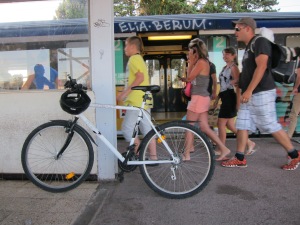 The train finally showed up at 7:15, fully loaded with frustrated passengers. I was barely able to squeeze on with my bike. I wasn’t going to make dinner reservations at eight. That much was clear. At this point, my primary focus was on my race with the sun. We pulled into Les Arcs-Draguignan station a little after 8pm and the light was starting to fade. Not even stopping for a drink of water, I hit the road fast, muscling it along the D10 to Taradeau and then along the D73 to Vidauban.
The train finally showed up at 7:15, fully loaded with frustrated passengers. I was barely able to squeeze on with my bike. I wasn’t going to make dinner reservations at eight. That much was clear. At this point, my primary focus was on my race with the sun. We pulled into Les Arcs-Draguignan station a little after 8pm and the light was starting to fade. Not even stopping for a drink of water, I hit the road fast, muscling it along the D10 to Taradeau and then along the D73 to Vidauban.
 The commune of Vidauban is only a couple of kilometers from Taradeau, and as I mentioned earlier in the post, it makes for a great pit-stop or even a day trip if you have the time. The approach into town from Lorgues spills down the windy D48 onto a tree-lined lane boasting picturesque grape fields on either side. There is a river just before you reach town where you can find people swimming, canoeing, and picnicking. The center of town is adorned with a large plaza surrounded on all sides by bars, cafes, and restaurants.
The commune of Vidauban is only a couple of kilometers from Taradeau, and as I mentioned earlier in the post, it makes for a great pit-stop or even a day trip if you have the time. The approach into town from Lorgues spills down the windy D48 onto a tree-lined lane boasting picturesque grape fields on either side. There is a river just before you reach town where you can find people swimming, canoeing, and picnicking. The center of town is adorned with a large plaza surrounded on all sides by bars, cafes, and restaurants.
On this particular evening I certainly did not have the time to stop in Vidauban for a leisurely drink. The reason for this detour is that the climb from Vidauban to Lorgues seems slightly more gradual than the disheartening ascent from Taradeau. Thus I took the D73 from Taradeau to the D48 in Vidauban where I turned right towards Lorgues.
By the time I got to the top of the hill it was about 8:45 and the last dim rays of sunlight were vanishing into dusk. I plodded along the last few kilometers to Lorgues with hamstrings that felt like they were going to snap. Once I was close to home, I guzzled the remaining bottle of water that was in my backpack. I must have drank close to two gallons throughout the course of the day. My friends were still at dinner, so I let myself inside the villa and took a shower. Absolutely famished, I raided the fridge and cupboards. Forging an appetizer plate of petit saucisson and cherries, I threw a pot of boiling water on the stove and cooked some farfalle with pesto and summer squash.
I thought of La Maison du Bon Poulet with every bite.
As always – any questions, comments, or updates to share please feel free to leave a comment below or contact me at asurlygentleman@gmail.com. On Twitter @escapebklyn. Keep rolling.
